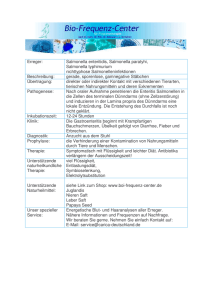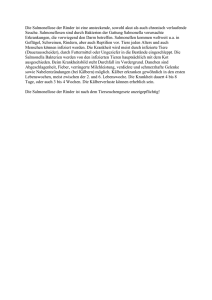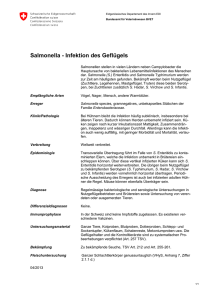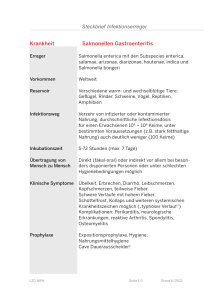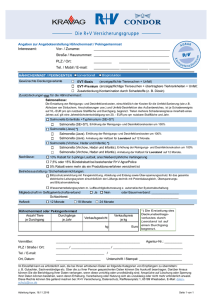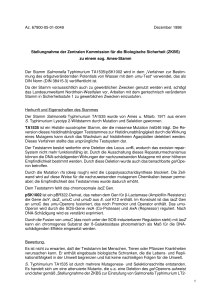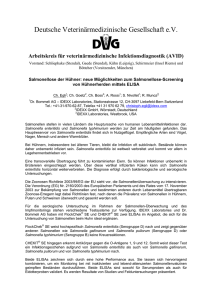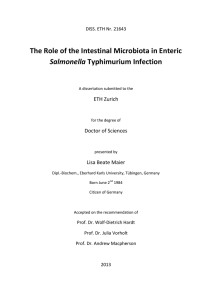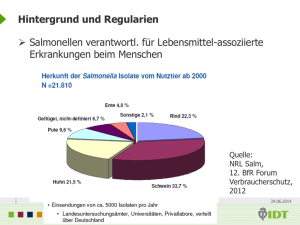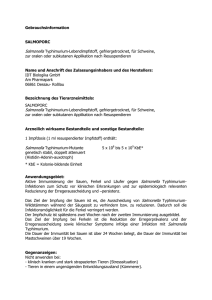quantitative analysis of diarrheal salmonella - ETH E
Werbung
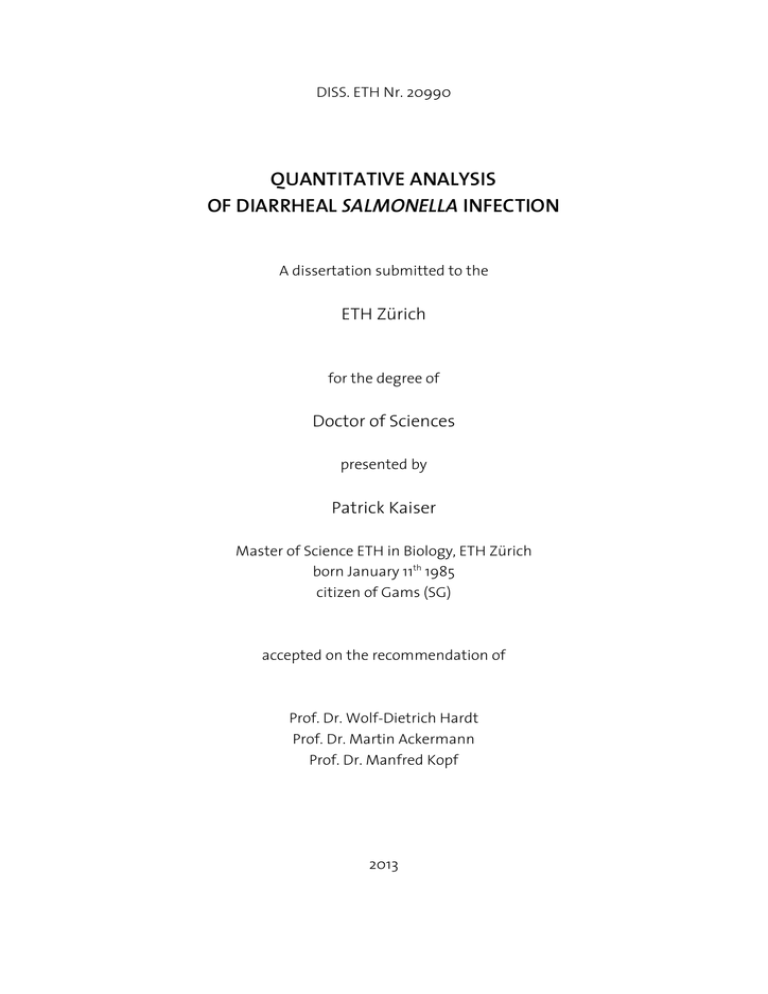
DISS. ETH Nr. 20990 QUANTITATIVE ANALYSIS OF DIARRHEAL SALMONELLA INFECTION A dissertation submitted to the ETH Zürich for the degree of Doctor of Sciences presented by Patrick Kaiser Master of Science ETH in Biology, ETH Zürich born January 11th 1985 citizen of Gams (SG) accepted on the recommendation of Prof. Dr. Wolf-Dietrich Hardt Prof. Dr. Martin Ackermann Prof. Dr. Manfred Kopf 2013 Thesis summary One of the most prominent and successful foodborne infectious agents is the gramnegative bacterium Salmonella enterica subspecies I serovar Typhimurium. Its broad host range spans from chickens, ducks and other birds to swine, cattle and humans. Most human infections emanate from the consumption of contaminated food derived from cattle or poultry products (i.e. meat and eggs). After ingestion, the pathogen grows to high numbers within the host's intestine and leads to first symptoms within 6 - 24h, ranging from nausea and abdominal pains to diarrhea. These symptoms are caused by innate immune responses to the bacterial infection and by toxins produced by the bacterium, which are injected into the intestinal epithelium, causing severe reprogramming of the target cells. The toxins (encoded on the Salmonella Pathogenicity Island - 1 (SPI-1)) induce the uptake of the bacterium into the epithelial cells and cause the secretion of pro-inflammatory cytokines, inducing a strong inflammatory response. Salmonella can profit from this inflammation, as it is more resistant to induced killing mechanisms and grows faster in the inflamed gut than the resident gut flora. Although invasion into epithelial cells has been studied extensively, the mechanism for crossing the epithelial cell and exiting on the basal side has remained elusive. Using a novel intravital microscopy method, we have shed light on this epithelial traversal mechanism. After host cell invasion, Salmonella Typhimurium crosses the epithelial cell using the second most prominent pathogenicity island present, SPI-2. SPI-2 is only expressed when the bacterium reaches an intracellular state and was long thought to be solely important for intracellular replication and systemic bacterial spread. We could provide evidence, that crossing of the epithelial cells from apical to basolateral side is also dependent on SPI-2, thus suggesting an additional function for this pathogenicity island. Furthermore, this process of epithelial traversal and exit into the lamina propria involves the expulsion of the bacterium together with host cell material on the basolateral side and subsequent uptake into resident phagocytic cells. Investigating bacterial infections using endpoint analysis and total tissue loads, leads to a very qualitative understanding of the infectious process. For full understanding, additional, population dynamical information is needed. It has become increasingly evident, that quantitative understanding of infections (i.e. exact site of entry, pathogen fluxes between different organs, dynamics of organ colonization) can be of great use for prevention and therapy. We developed a mathematical model for the first steps in Salmonella Typhimurium infection, namely the colonization of the cecal lymph node. The model was fit to experimental data gained from infection experiments using phenotypically identical, isogenic tagged Salmonella strains that only differed in the carriage of a unique 40 base pair tag (which can be detected by real time PCR). The stochastic loss of these tags from the gut lumen to the lymph node and their relative abundance gives insight into changes within the infectious bacterial population. Parameters derived from these experiments revealed that only very low numbers (300 bacteria in the first 24h) ever reach the draining lymph node, where they double every 6h to reach a final density of ~ 2000 bacteria. 3 Under normal conditions non-typhoidal Salmonella spp. (NTS) only cause a self-limiting gastronenteritis in humans. In certain patients, such as infants, elderly or immunecompromised persons, complicated systemic infections can arise. This typhoid fever like disease is a severe threat and has to be treated with antibiotics. In contrast to the diarrheal disease, where antibiotics are incapable of reducing disease length, systemic salmonellosis can be treated with appreciable success. Nevertheless, even treatment with antibiotics is incapable of completely removing the pathogen from the host organism. Relapsing disease is often observed after antibiotic therapy is discontinued, leading to a new wave of Salmonella infection caused by bacteria not fully cleared from the host. To study relapsing infections, we adapted the streptomycin pretreated mouse model to mimic infection and antibiotic therapy in humans. Antibiotic tolerant bacteria were found to be lodged in draining lymph nodes, specifically within dendritic cells. These bacteria were found to be the source of relapsing infections and their antibiotic tolerance to be strongly dependent on their dendritic cell niche. To understand what makes these bacteria antibiotic tolerant, we made use of stochastic fluctuations in the population dynamics of the infectious Salmonella and combined this with mathematical modeling. From this model, growth, killing and migration parameters of primary Salmonella infection and subsequent antibiotic treatment could be derived. These parameters indicated that upon antibiotic treatment, Salmonella in the lymph node form a very slow growing, but highly antibiotic tolerant population that can persist for up to ten days under high antibiotic concentrations. This demonstrates how quantitative measurement of a pathogens population dynamics can be used to analyze the success or failure of infection and therapy. 4 Zusammenfassung Eine der weltweit häufigsten Lebensmittel-assoziierten Bakterien ist Salmonella enterica Subspezies I serovar Typhimurium. Nach dem Verzehr von kontaminierten Nahrungsmitteln, siedelt sich das Pathogen im Darmtrakt des Wirtes an. Dort löst es meistens eine starke lokale Entzündung aus, welche sich durch Symptome wie Durchfall, Schwindel, Erbrechen und Bauchkrämpfe zu erkennen gibt. Diese Entzündungsreaktion wird durch die Injektion von bakteriellen Toxinen und das darauf folgende Eindringen des Bakteriums in die Darmepithelzellen ausgelöst. Ein Teil der Entzündung wird aktiv durch das Pathogen induziert, während die restliche Entzündungsreaktion durch das Immunsystem induziert wird, welches Bestandteile des eindringenden Bakteriums erkennt. Das Eindringen in Epithelzellen und die zugrunde liegenden molekularen Mechanismen wurden in der Vergangenheit eingehend untersucht. Verschiedene bakterielle Toxine, sogenannte Effektorproteine, und deren biochemischen Eigenschaften wurden beschrieben und sowohl in Zellkultur wie auch in Tiermodellen erforscht. Nach dem Eindringen in die Darmepithelschicht, besiedelt Salmonella Typhimurium die darunter liegende Submukosa. Obwohl die Invasion ins Epithelgewebe und die Besiedlung der darunter liegenden Zellschicht, der lamina propria, lange bekannt ist, blieb es lange rätselhaft ob und wie die Bakterien die Epithelzellen wieder verlassen. Im ersten Teil der vorliegenden Arbeit, haben wir dank einer neuen von uns entwickelten Technik, der Intravitalmikroskopie, genau diesen Schritt in der Infektion untersucht. Wir konnten zeigen, dass Salmonella Typhimurium nach dem Eindringen in die Epithelzelle, von der apikalen zur basolateralen Seite migriert und dort aus der Epithelzelle zusammen mit Epithelmaterial austritt. Dieser ganze Prozess ist abhängig von Virulenzfaktoren, welche auf der Salmonella Pathogenitätsinsel 2 (SPI-2) kodiert sind. Bisher wurde dieser Virulenzfaktor nur mit intrazellulärem Wachstum und der Fähigkeit des Pathogens systemische Infektionen auszulösen assoziiert. Mit dieser Arbeit ergänzen wir das Funktionspektrum von SPI-2 um eine weitere Facette. Derzeitige Forschung an Infektionskrankheiten fokussiert sich vor Allem auf molekulare Mechanismen und qualitative Aussagen über den Infektionsverlauf. Dies rührt meist daher, dass Tierexperimente nur mittels Endpunktanalyse ausgewertet werden können und somit das mehrfache Beproben derselben Organe nicht möglich ist. Um Aussagen über die Zeit zwischen zwei Messpunkten treffen zu können, muss Interpoliert werden. Diese Interpolation lässt jedoch nur grobe Aussagen zu und vernachlässigt dynamische Änderungen, welche schlichtweg nicht sichtbar werden. Um genauere Aussagen über dynamische Prozesse in Infektionen treffen zu können, braucht es neue Populationsbiologische Ansätze. In dieser Arbeit wird gezeigt, wie man mit Hilfe von neutralen genetischen Etiketten und einem mathematischen Modell Infektionsparameter bestimmen kann, welche eine genaue Aussage über die dynamischen Prozesse der Infektion erlauben. Wir haben ein Modell entwickelt in dem wir den ersten Schritt der Salmonella Typhimurium Infektion, die Besiedlung des caecalen Lymphknotens beschreiben können. Mit dessen Hilfe lassen sich zB. 5 Vorhersagen über die Effektivität von Impfungen machen. In einem zweiten Schritt haben wir diese Methodik zur Optimierung/Untersuchung von Therapien angewendet. Weltweit erkranken bis zu einer Milliarde Menschen jährlich an Salmonella spp., wobei ca. drei Millionen Erkrankungen tödlich ausgehen. In industrialisierten Ländern ist die Gefahr an Salmonella spp. zu sterben relativ gering, ausser man gehört zur Risikogruppe der Alten, Kleinkinder und Immunsupprimierten. In dieser Risikogruppe kann die lokale Darmentzündung schnell zu einer sehr gefährlichen körperweiten, systemischen Infektion ausarten, welche akute medizinische Hilfe erfordert. In solchen Fällen werden die Patienten mit Antibiotika, meist Ciprofloxacin, behandelt. Die Behandlung ist meistens erfolgreich, doch es geschieht oft, dass nach Absetzten der Antibiotika ein Rückfall eintritt. Dies führt zu einer erneuten Hospitalisierung des Patienten und zu weiterer Antibiotikatherapie. Um herauszufinden wieso Salmonella spp. nicht immer durch Antibiotikabehandlung eliminiert werden können, haben wir unser Mausmodell so angepasst, dass Rückfälle untersucht werden können. Wir haben herausgefunden, dass die Bakterien, welche für den Rückfall verantwortlich sind, sich im Lymphknoten befinden und dort in speziellen in dendritischen Zellen zu finden sind. Durch eine Erweiterung unseres mathematischen Modelles konnten wir zeigen, dass die persistenten Bakterien sich unter Antibiotikabehandlung sehr langsam teilen und in eine Art Dauerzustand übergehen. Diese Erkenntnis konnte nur dank der quantitativen populationsdynamischen Analyse gewonnen werden und zeigt wie wichtig solche Analysen in der Zukunft sein werden. 6
